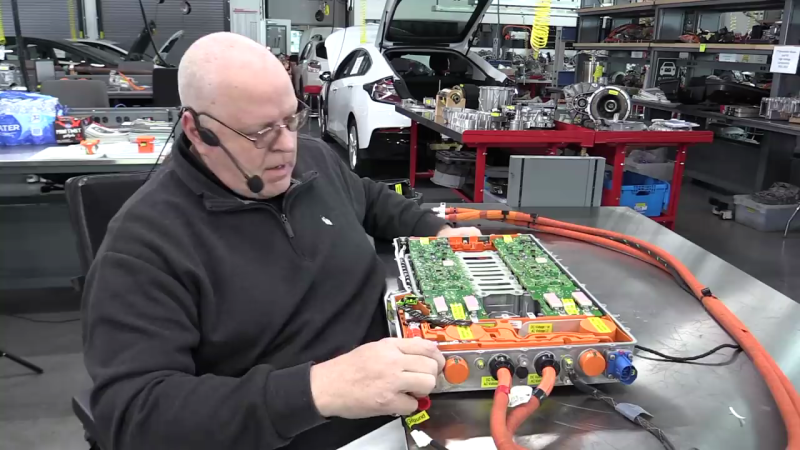When he’s not busy with his day job as professor of computer and automotive engineering at Weber State University, [John Kelly] is a prolific producer of educational videos. We found his video tracing out the 22+ meters of high voltage cabling in a Tesla Model S (below the break) quite interesting. [John] does warn that his videos are highly detailed and may not be for everyone:
This is not the Disney Channel. If you are looking to be entertained, this is not the channel for you.
We ignored the warning and jumped right in. The “high” voltages in the case of an electric vehicle (EV) like the Model S is approximately 400 volts. Briefly, external input via the charge connector can be single or three phase, 120 or 250 VAC, depending on your region and charging station. This get boosted to a nominal 400 VDC bus that is distributed around the various vehicle systems, including the motors and the battery pack.

Rear Modules
-
- Charge receptacle
- On-board charger module
- Rapid splitter
- Rear motor inverter
Front Modules
-
- High voltage junction block
- Cabin air heater
- DC to DC converter
- Battery coolant heater
- Air conditioning compressor
- Front motor inverter
He goes through each module, showing in detail the power routing and functionality, eventually assembling the whole system spanning two work benches. We liked his dive into the computer-controlled fuse that recently replaced the standard style one, and were impressed with his thorough use of labels.
If you’ve ever been curious about the high voltage distribution of a EV, grab some popcorn and check out this video. Glancing through his dozens of playlists, [John]’s channel would be a good place to visit if you’re interested any topic related to hybrids and electric vehicles, drive trains, and/or transmissions. We’ve written about some Tesla teardowns before, the Model 3 and the Model S battery packs. Have you worked on / hacked the high voltage system in your EV? Let us know in the comments below.

















This guy is pretty good. He had an earlier series where he tore apart some toyota eCVT transmissions showing the difference between planetary and belts.
Not sure whether <> is meant ironically. 400 VDC is much more dangerous than 400 VAC due to the fact that if your body conducts the muscles lock in and you’ll get a nice long ZAP, whereas with AC you’re likely to retract your finger/hand quicklty. (Sorry for the non-scientific explanation.)
Ughh, can’t use angular brackets to quote something… I love the preview button here… Trying again…
Not sure whether:
The “high” voltages in the case of an electric vehicle (EV) like the Model S is approximately 400 volts.
is meant ironically. 400 VDC is much more dangerous than 400 VAC due to the fact that if your body conducts the muscles lock in and you’ll get a nice long ZAP, whereas with AC you’re likely to retract your finger/hand quicklty. (Sorry for the non-scientific explanation.)
Begging your pardon, but I got locked, hand to hand, across my chest between neutral and live on an A/C feed for 20 or 30 seconds. Half the volts, but think of it like pulsed DC. It’s just on-off instead of forward-reverse. Your muscles can’t react in time with 60hz. Fortunately, I had the presence of mind to realize my legs still worked, and was able to stomp the armored conduit, yanking it from my hand, while several people watched in curiosity, wondering what I was doing.
A/C and D/C are equally dangerous. A/C also stimulates your sweat glands, rapidly reducing your skin resistance as time passes. D/C might be a violent, but quick death, but A/C has the power to let you feel the full experience of dying, as you watch, helplessly.
Wow. Glad you lived to tell the tale! I’ve been zapped by a few mains power things, and I know that feeling of mental shock when you just don’t know what’s going on or how to respond. For me, those issues resolved themselves as I contracted and lurched away. Getting stuck like that must have been terrifying. Such a situation should always be immediately followed by packing up, going to the pub, then drinking till time to go home.
Mains is 240Volts in my country and arm to arm or any limb to left arm is usually fatal.
I’m glad you’re still with us and I hope that your disclosure of your experience encourages other to be careful.
You probably just saved someones life, not just your own.
Done 240, lucky stiffs that screwdriver didn’t go the wrong way.
Wrong had and seen many 240v shocks all good,
I’m pretty sure it’s high in quotes because high voltage usually means 1000VAC or 1500VDC so it’s not “real” high voltage but instead high in terms of voltages found inside cars.
Per the (US) National Electric Code, anything above 48V is “high voltage”. Yes, laugh. Still, once you get above 120VAC you start having to take extra precautions. 400VDC is nothing to sneeze at, it will hurt or kill you.
According to Wikipedia even in the US 400V is classified av low voltage when talking about anything else than vehicles. I didn’t say low voltage was safe. Your household electrical outlets are low voltage but still not safe, they are just low compared to everything else in the power grid.
Any English description is subjective, meaning different things to different people in different places or personal experience. Temperature is “too high”, versus, the temperature is 125C (above the boiling point of pure water at 1 ATM pressure). Objective is always a number. For Engineering, “the answer is always in the numbers”.
Like dimensionless decibels, a reference is required to make it relative. Problem is, most humans, even many technical folk speak commonly in subjective terms.
Spock
You know nothing about electricity.
[John Kelly] is Great! I devoured his Prius Gen 2 series while I was rebuilding mine.
I really do wonder sometimes if a stupid EV car would sell well, one with no remote telemetry harvesting, basically as low tech as possible. Not quite accelerator, breaks (with break lights), motors, steering wheel (with indicator lights), headlights and battery – but as close to that as is feasible.
In the UK that’s known as a milk float.
Murricans have no idea of what a milk float is. Or the fact that it has existed for so long!
It’s like a Root Beer Float, but with milk instead of root beer.
B^)
https://en.wikipedia.org/wiki/Milk_float
Yes! I want one. I do not need or want “over the air updates” no screens, just a few small ones to show pertinent information, as basic computer control as possible, I’m fully capable of operating a motor vehicle and all it’s driver inputs. All I want is a box with wheels (minivan anyone?) and a nice big battery to go at least 500 miles at 80mph on a charge. Don’t need sub 4 seconds acceleration either. 6 seconds is more than adequate. Top speed is not relevant above 100mph. And it needs to cost under 30k and have Chrysler style disappearing seats.
Sounds like you need one of those conversion kits that got covered here a year or two ago. I agree this is an underserved market. If you see someone start to sell cars like that, buy their company’s stock.
I think the word you wanted was “brakes”. “Breaks” is a verb.
Unless you’re talking about “the Missouri Breaks”.
They may come in time but for now if you’re spending big bucks on an EV you also need every bell and whistle to feel like the price was justified. Would you spend 30 grand on a car that doesn’t have air con? Citroen have their Ami, Renault their Twizy, both of these tick the simplicity box but had to pare back on features to hit a low price point.
Preach!
I guess once the likes of Dacia start releasing EV’s they’ll strip a lot of the BS out. I really like the look of the Honda e, apart from the wall-to-wall screens instead of a normal dash… if they did a cheap version with a simple gauge pod I’d have one in a flash.
On the plus side, EV’s are super simple at the basic level so very hackable, should be easy enough to strip everything out and still have some way of driving it – I would be amazed if there isn’t an open-source EV drive & charge controller on HaD in the next 5 years.
At least, it’s shielded. Cars are such RFI bombs these days. They generally economize with bundle-shielding, which means every wire ends up being an antenna for whatever RFI is created.
With the HV, it has to be shielded to protect the user from HV.
Shielding is to protect against EMC. The HV modules and cabling are generating noise that could drive issues to the overall electrical and electronic systems and then cause problems to the vehicle functions.
Cars have always been RFI bombs. Especially old spark gap distributors were horrible.
I once tried to make a speedometer for a moped.. the PIC16F started resetting itself when it was closer than 1 meter to the engine.
That’s why they use diesel cars around radio telescopes.
Old diesels yes – modern diesels have more electronics than petrols by my reckoning.
Agreed, it changed right around 2000. My 1997 peugeot 306 with an xud9 turbo diesel needed 4 wires (earth, 12v feed to the pump shutoff solenoid, 12v feed to the glow plugs, 12v feed to the starter). You could lose the pump solenoid one if you took the plunger out, but you’d have to stall it to stop the engine.
By contrast, my 2000 plate 306 turbo diesel was fitted with a computer controlled common rail engine. Uses a bosch EDC15 ECU and has something like 8 or 9 different factors that influence the fuel quantity injected, only one of which is the demand from the throttle pedal!
That was built 22 years ago(!) and it’s only got worse in terms of electronics from there.
If memory serves right, diesels are still better in those areas because the spark (and the components that generate it) are the main RF noise sources by a large margin
That second conductor is essential for detecting isolation fauls.
With 400V DC you need to make sure that any anomalies will lead to a shutdown. I would imagine that just a single electrocution incident would make the news…
I would see only a partial shielding function of that conductor. For a perfect shield, it needs to be solid around both conductors. I would love to see some numbers
Interference in an electric car could change broadcasting if the rest of changes don’t. Many who listen to AM radio (right wing) would never have an electric anyway. I wonder if any current electrics have an AM-MW band on the radio and if it takes less than several taps on a screen to find out.
There’s Chinese microcars that are like that and are pretty cheap. EVs in ‘Murica are luxury trim because they cost so much anyhow, might as well fill them with doodads and gismos. Same thing happened a hundred years ago; only rich folks had cars then Henry Ford came along.